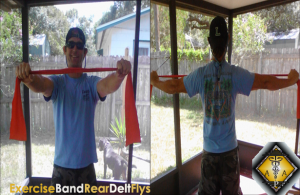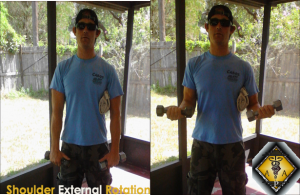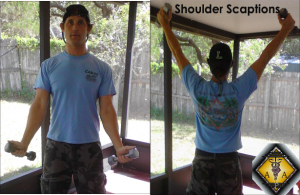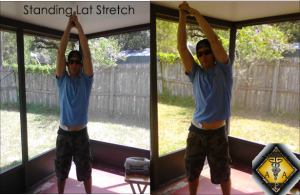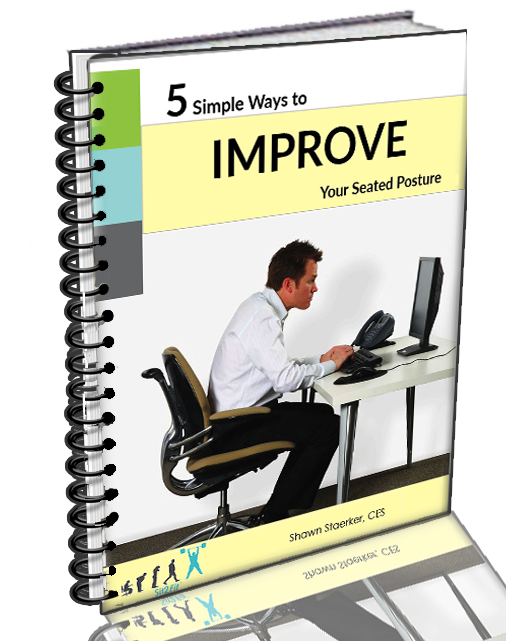During any given conversation regarding my web address (saddlefitness.com) or the origin of Equestrian Physiology, a term being used with increasing frequency, I am often asked to explain some common imbalances faced by horse riders. What better way, I thought, to introduce myself to the world of “blogging” than with a few short enlightening and entertaining entries regarding common equestrian muscular imbalances.
Let’s head off any questions about where to start this series and go with a common above-the-trunk affliction: Shoulders in a rounded position.
What’s Happening?
In order for the shoulders to round, several muscles must contract. This also means that muscles on the opposite side of those tightened muscles must give way, or loosen. If a person constantly has rounded shoulders, then the muscle groups responsible for making that action happen become used to staying in their respective positions—creating chronic tightness/weakness. In addition, due to the muscles being held in one (incorrect) position, a rider’s ability to activate those muscles using the nervous system (mind/muscle connection) can become affected.
Below are some of the muscles commonly seen in the “shoulders forward” postural position:
Tight: lats, pecs (chest), teres major
Weak: mid/low traps, rhomboids, rotator cuff
Take My Breathe Away
Having rounded shoulders, due to the muscles required to maintain this position, also means that riders will find themselves breathing less efficiently. This abnormal breathing (called “chest breathing) results partially from the traps pulling on muscles higher up the neck (the scalenes) that lift the ribs in an attempt to open the torso and receive more air. “Chest breathing” further perpetuates the cycle by tightening the chest, which in turn tightens the traps, scalenes, etc.
Normal breathing requires that the airway not be constricted by a tight chest/shoulder combination and uses a muscle within the torso called the diaphragm. With the torso in proper alignment, riders will find an ability to fill and empty the lungs completely, resulting in greater blood flow and a relaxing of tight muscles. No matter what discipline a rider follows, or whether a professional or an amateur—a relaxed rider will go a loooooong way towards a relaxed horse!!!
Practically, Everything
Because many of us are simply recreational or amateur riders—and have other professions, there are probably movements or positions in those non-riding (or “real-world”) activities that may worsen the “shoulders forward” position.
Let’s consider an amateur rider who works a 9-5 desk job (even professional riders must sit and complete endless hours of paperwork on occasion!) and rides 2-3 times weekly: There is a great chance that this individual will have a “shoulders rounded” position from the endless hours sitting at a desk, typing or talking on a phone. Couple that fact with the potential postural challenge of equestrian activities and there is a fair chance that this individual can benefit from designated exercises and stretches designed to help pull the head, neck and shoulders into a more favorable resting position.
Not Forward Thinking
Although there are times and places when having the shoulders rounded or the head forward of your torso are advantageous (it’s doubtful that the body would allow you to move into positions for which there is NO purpose), generally speaking, this is not an ideal posture. From altered breathing patterns to tense shoulder muscles and possible headaches, the negative benefits of a “shoulders rounded” posture are annoying at best and can cause sub-standard or painful riding.
Get Up Offa’ That Thing
Try these exercises two or three times a week for the next month and see if you are able to notice a difference in your riding posture.
Exercise Band Rear Deltoid Flys.—
Hold an exercise band/Thera Band with your arms straight out in front of you with only a little slack in the band. (You may have to try a couple of different band lengths before finding one that holds tension throughout a majority of the movement). Pull the band outward with your hands and squeeze the shoulder blades together you move. 2-3 sets of 15-20 repetitions each should work great here.
Dumbbell Scaptions—
With one light dumbbell in each hand, hold the arms down along your legs at a 45 degree angle (a v-shape). Raise your arms in a “V” or “Y” shape, with the arms and dumbbells coming overhead. Perform 15-20 repetitions during 2-3 sets.
Shoulder External Rotation—
Roll up a towel or other soft cloth and place under your arm on the working side. With a light (2-5 lb) dumbbell in the same hand, rotate the shoulder externally. Think of a visual of placing your hands in the pants pockets and bringing them out with your palms facing upward—as if to show someone you have “no money” in your pockets. Repeat for 20-25 repetitions and 2 sets on each side.
Standing Lat Stretch—
Grab a chair, pillar, bedpost or other supporting object with one both hands around it and sit down, as if you are trying to drag the object down with your weight (although not using your full weight until comfortable with the stretch—and in some cases, never using the full weight). Hold for 25-45 seconds.
Seated Scalene Stretch—
While seated, reach across the top of your head and grab the left ear, gently pulling the head towards your right shoulder. Hold while tight for 25-45 seconds, and repeat with the left arm.
